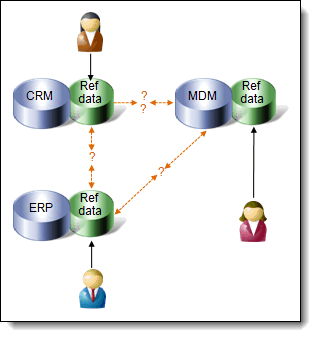About cookies on this site Our websites require some cookies to function properly (required). In addition, other cookies may be used with your consent to analyze site usage, improve the user experience and for advertising. For more information, please review your options. By visiting our website, you agree to our processing of information as described in IBM’sprivacy statement. To provide a smooth navigation, your cookie preferences will be shared across the IBM web domains listed here.
Abstract
Reference data is a key aspect of any application integration. Today, many enterprises have no centralized enterprise governance and management over reference data. Reference data variations and inconsistencies can be a major source of data quality issues within the enterprise and can cause business losses through system downtime, incorrect transactions, and incorrect reports. IBM® InfoSphere® Master Data Management Reference Data Management Hub (InfoSphere MDM Ref DM Hub) is designed as a ready-to-run application that provides the governance, process, security, and audit control for managing reference data as an enterprise standard, resulting in fewer errors, reduced business risk, and cost savings. This IBM Redbooks® Solution Guide highlights the value of this powerful solution and describes how to implement it in your organization
Contents
Reference data refers to data that is used to categorize other data within enterprise applications and databases. Reference data includes the lookup table and code table data that is found in virtually every enterprise application, such as country codes, currency codes, and industry codes.
Reference data is distinct from transactional data and master data. Transactional data is the data that is produced by transactions within applications; master data is the data that represents the key business entities that participate within transactions. Reference data is also distinct from metadata, which describes the structure of an entity. Transactional data, master data, and reference data, when combined, comprise the key business data within an enterprise.
Most enterprise applications contain reference data, built into code tables, to classify and categorize product information, customer information, and transaction data. Reference data changes relatively infrequently, but it does change over time, and given its ubiquity, synchronizing reference data values and managing changes across the enterprise is a major challenge (Figure 1).

Figure 1. Reference data is found everywhere
Did you know?
Reference data has been part of enterprise applications from the beginning of the modern computing era. However, despite this fact and the fact that it constitutes a fundamental class of enterprise data, there is relatively little focus on reference data and its importance as an enterprise data asset.
Ad hoc management of reference data without a formal governance policy can create significant operational risk. For many enterprises, reference data is a major contributor to enterprise data quality problems and has a high support cost. The demands of complying with national and international industry regulations are causing companies to rethink reference data management, and compelling enterprises to manage and control their reference data by using sound data governance principles. IBM® InfoSphere® Master Data Management Reference Data Management Hub (InfoSphere MDM Ref DM Hub) is an ideal solution for reference data management.
Business value
Today, many companies have no centralized enterprise governance over reference data; critical reference data is managed using spreadsheets and manual, ad hoc methods. The difficulty of managing change across the complex web of reference data variations is not systematically addressed; errors in reference data mappings and inconsistencies are accepted and tolerated as an everyday reality. Reference data variations and inconsistencies can be a major source of data quality issues within the enterprise and cause business losses through system downtime, incorrect transactions, and incorrect reports.
InfoSphere MDM Ref DM Hub provides a robust solution for centralized management, stewardship, and distribution of enterprise reference data. It supports defining and managing reference data as an enterprise standard. It also supports maintaining mappings between the various application-specific representations of reference data that are used within the enterprise. The InfoSphere MDM Ref DM Hub supports formal governance of reference data, putting management of the reference data in the hands of the business users, reducing the burden on IT, and improving the overall quality of data used across the organization.
By centrally managing and distributing reference data within the enterprise with InfoSphere MDM Ref DM Hub, organizations can realize the following benefits:
Others who read this also read
Special Notices
The material included in this document is in DRAFT form and is provided 'as is' without warranty of any kind. IBM is not responsible for the accuracy or completeness of the material, and may update the document at any time. The final, published document may not include any, or all, of the material included herein. Client assumes all risks associated with Client's use of this document.
